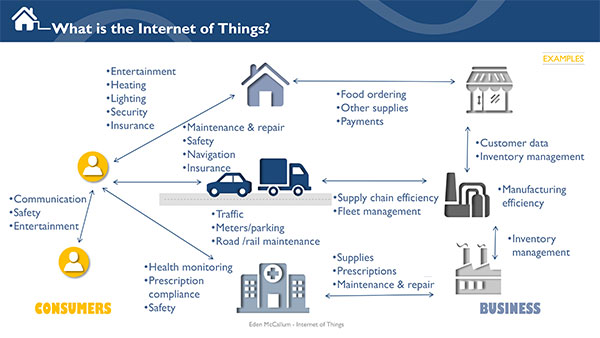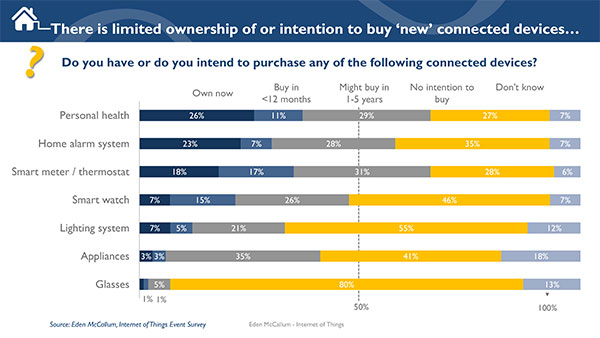Today’s creepy is tomorrow’s normal – perspectives from an Eden McCallum panel on the “internet of things”
Eden McCallum hosts a panel discussion on the “internet of things” and connected homes
It has been said, by the writer William Gibson, that “the future is already here, it’s just not evenly distributed”. As far as exciting new products are concerned there has often been a delay between the promise of new technology and the reality becoming an everyday item in our homes or offices.
To try and pin down what the “internet of things” might look like in practice, especially in the context of home life, Eden McCallum hosted a discussion at the RSA in London in May. To help in that task we were joined by an informed panel of speakers:
Andy Griffiths, President of Samsung Electronics UK;
Nina Bhatia, Commercial Director for British Gas;
Lionel Paillet, General Manager in Europe for Nest Labs (acquired by Google last year);
and Sebastian James, Group Chief Executive, Dixons Carphone
The task was to distinguish between hype and achievable reality.
Watch highlights of the discussion
As outlined by Eden McCallum Founding Partner Dena McCallum in her opening remarks, industry growth estimates are dramatic. A recent Gartner study, and other sources, have estimated that by 2020 the number of connected people will grow from 2.5 billion to 5 billion, that apps will increase from over 3 million to over 25 million, that connected devices will grow from about 5 billion to over 25 billion, and that the gigabytes of data will nearly double every two years from about 4.4 trillion now to 50 trillion.
This would be a truly connected world.

How will businesses make this connected world work for their customers?
Will all products “speak” to each other regardless of brand, as Samsung’s Andy Griffiths has suggested? Will the customer be truly in control of their home in a way that hasn’t been possible before, as British Gas’s Nina Bhatia has argued? Perhaps this would bring about what Nest has called the “thoughtful home” – “thoughtful” being a rather more imaginative and evocative way of saying “smart”. Certainly Sebastian James of Dixons Carphone is bullish: he has estimated that homes in the relatively near future could contain as many as 70 connected devices.
According to Bill Gates: “We always overestimate the change that will occur in the next two years and underestimate the change that will occur in the next ten.” So how can we tell hype from reality?
A survey of senior executives carried out by Eden McCallum (145 responses) suggested that even relatively “switched on” and prosperous people are not convinced that the internet of things is changing their lives, yet. Respondents had only 3.4 connected devices per person against a national average of 3.1.

Not everyone could see the value of “connectability”. Clearly the smartphone is a revolutionary product. But what else is, or could be?
Andy Griffiths of Samsung said that by 2020 all his company’s hardware would be “IoT enabled”. The television in particular could prove to be the hub of a connected home.
The Samsung view is that connectivity will only come by working with partners. “We’re only limited by our imagination and willingness to work collaboratively,” he said. And this will require openness.
Andy Griffiths: Millennials expect this kind of technology
Nina Bhatia from British Gas said that customers had to find the “internet of things” meaningful – it couldn’t just be about products. “We don’t talk about the ‘internet of things’,” she said, “we talk about homes.”
British Gas’s Hive service allows customers to regulate their heating remotely. 50% of customers are using it daily, while at home about 30% don’t know how to use the controls they have.
In her experience, women customers are not impressed by “toys for boys”. The services have to be meaningful for ordinary people and not just geeks, she added.
Nina Bhatia: Demonstration is key
Lionel Paillet from Nest quoted his company founder Tony Fadell, designer of the iPod, who has asked: “Is there a way our homes can take care of us?”
After all, 75% of house fires in the UK occur in homes with smoke alarms that are not working.
He too endorsed the idea of “emotional” products being the right way to win customers over. “Great products prevail, ones that are really focused around the customer and the experience” he said.
Lionel Paillet: Just “connected” is not enough
Sebastian James from Dixons Carphone wondered whether the “internet of things” label was too wide a definition, one that was slowing down the take-up of products.
He said over the next two years his company would have to work out how to market, sell and service these products, becoming eventually an integral part of how customers run their homes.
Sebastian James on the real magic in IoT
During the discussion and questions from the floor, facilitated by Ravi Mattu, TMT editor at the Financial Times, Andy Griffiths described the way millennials are expecting more and more in terms of product capabilities, though the full product set to deliver a complete, combined experience is not here yet.
Nina Bhatia, pointing out that some elderly customers are already capable of using IoT services, emphasised the importance of education and live product demonstration.
Sebastian James agreed, suggesting that this gave bricks and mortar retailers an advantage over Amazon. He said the task was really about showing how “today’s creepy is tomorrow’s normal”.
“Connectivity is not the smart bit”, Nina Bhatia said, “relevance is.”
“The world is going to feel telepathic,” Sebastian James predicted. “We are going to be served [by products/services] before we even know that we need something.”
Today that might sound a bit creepy. But it could become the new normal.
–Ends–

